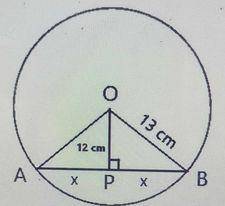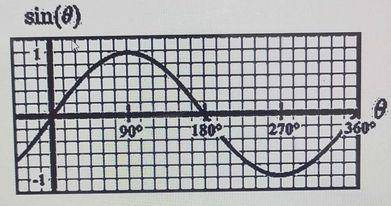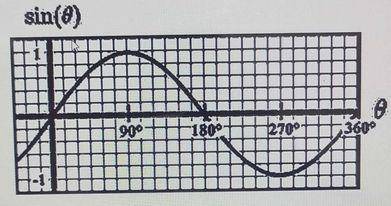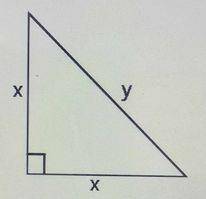16 cm
8 cm
5 cm
10 cm
Correct answer is D

|AP| = |PB| = \(x\) (The perpendicular to a chord bisects the chord if drawn from the center of the circle.)
From ∆OPB
Using Pythagoras theorem
⇒ \(13^2 = 12^2 + x^2\)
⇒ \(169 = 144 + x^2\)
⇒ \(169 - 144 = x^2\)
⇒ \(x^2 = 25\)
⇒ \(x = \sqrt25 = 5 cm\)
∴ Length of the chord |AB| = \(x + x = 5 + 5 = 10 cm\)

θ = 223\(^o\), 305\(^o\)
θ = 210\(^o\), 330\(^o\)
θ = 185\(^o\), 345\(^o\)
θ = 218\(^o\), 323\(^o\)
Correct answer is D

On the \(y\)-axis, each box is \(\frac{1 - 0}{5} = \frac{1}{5}\) = 0.2unit
On the \(x\)-axis, each box is \(\frac{90 - 0}{6} = \frac{90}{6} = 15^o\)
⇒ \(θ_1 = 180^o + (2.5\times15^o) = 180^o + 37.5^o = 217.5^o ≃ 218^o \)(2 and half boxes were counted to the right of 180\(^o\))
⇒ \(θ_2 = 270^o + (3.5\times15^o) = 270^o + 52.5^o = 322.5^o ≃ 323^o \)(3 and half boxes were counted to the right of 270\(^o\))
∴ \(θ = 218^o, 323^o\)
62 km
97 km
389 km
931 km
Correct answer is A
AB = \(\frac{θ}{360}\times 2\pi Rcos\propto\) (distance on small circle)
= 64 - 56 = 8\(^o\)
\(\propto = 86^o\)
⇒ AB = \(\frac{8}{360}\) x 2 x 3.142 x 6370 x cos 86
⇒ AB = \(\frac{22,338.29974}{360}\)
∴ AB = 62km (to the nearest km)
The perimeter of an isosceles right-angled triangle is 2 meters. Find the length of its longer side.
2 - \(\sqrt2\)
-4 + 3\(\sqrt2\)
It cannot be determined
-2 + 2\(\sqrt2\) m
Correct answer is D

Perimeter of a triangle = sum of all sides
⇒ \(P = y + x + x = 2\)
⇒ \(y + 2x = 2\)
⇒ \(y= 2 - 2x\)-----(i)
Using Pythagoras theorem
\(y^2 = x^2 + x^2\)
⇒ \(y^2 = 2x^2\)
⇒ \(y = \sqrt2x^2\)
⇒ \(y = x\sqrt2\)-----(ii)
Equate \(y\)
⇒ \(2 - 2x = x\sqrt2\)
Square both sides
⇒ \((2 -2x) ^2 = (x\sqrt2)^2\)
⇒ \(4 - 8x + 4x^2 = 2x^2\)
⇒ \(4 - 8x + 4x^2 - 2x^2 = 0\)
⇒ \(2x^2 - 8x + 4 = 0\)
⇒ \(x = \frac{-(-8)\pm\sqrt(-8)^2 - 4\times2\times4}{2\times2}\)
⇒ \(x = \frac{8\pm\sqrt32}{4}\)
⇒ \(x = \frac{8\pm4\sqrt2}{4}\)
⇒ \(x = 2\pm\sqrt2\)
⇒ \(x = 2 + \sqrt2\) or \(2 - \sqrt2\)
∴ \(x = 2 - \sqrt2\) (for \(x\) has to be less than its perimeter)
∴ \(y = 2 - 2x = 2 - 2(2 - \sqrt2) = -2 + 2 \sqrt2\)
∴ The length of the longer side = -2 + 2\(\sqrt2\)m
270 km
200 km
360 km
450 km
Correct answer is B
Speed = \(\frac{Distance}{Time}\)
⇒ Time = \(\frac{Distance}{Time}\)
Let D = distance between the two airports
∴ Time taken to get to the airport = \(\frac{D}{120}\) and Time taken to return =\( \frac{D}{150}\)
Since total time of flight= 3hours,
⇒ \(\frac{D}{120} + \frac{D}{150}\) = 3
⇒ \(\frac{15D + 12D}{1800}\) = 3
⇒ \(\frac{27D}{1800}\) = 3
⇒ \(\frac{3D}{200} = \frac{3}{1}\)
⇒ 3D = 200 x 3
∴ D =\(\frac{ 200\times3}{3}\)= 200km
JAMB Subjects
Aptitude Tests
Latest Jobs
Indorama Eleme Fertilizer & Chemicals Limited (IEFCL) Graduate Engineer Internship Program 2024
Diploma Engineer Internship Program at Indorama Eleme Fertilizer & Chemicals Limited (IEFCL)
Admin Officer - Airline Industry at Ascentech Services Limited
Area Sales Manager at Airtel Nigeria
State Business Manager at Airtel Nigeria
Inventory Manager at a Reputable Agricultural Company
Supply Chain Officer at Kellogg's Tolaram Nigeria Limited (KTNL)
Warehouse Manager at Shulifang Biotechnology FZE
Capability Development & Execution Excellence Manager (Rivers) at Airtel Nigeria
Regional Security Manager - Northeast Region at Airtel Nigeria